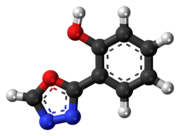

 | |
 | |
| Clinical data | |
|---|---|
| Trade names | Hypnazol, Eudormil, Viodor |
| Other names | Fenadiazol; Fenadiazolum; Fenodiazole; Phénadiazole; Phenadiazole; JL-512; J. L. 512; NSC-100729; 2-(o-Hydroxyphenyl)-1,3,4-oxadiazole; 2-(2-Hydroxyphenyl)-1,3,4-oxadiazole; o-1,3,4-Oxadiazol-2-ylphenol |
| Routes of administration | By mouth |
| ATC code |
|
| Identifiers | |
| |
| CAS Number | |
| PubChem CID | |
| ChemSpider |
|
| UNII | |
| ChEBI | |
| ChEMBL | |
| CompTox Dashboard (EPA) | |
| ECHA InfoCard | 100.206.148 |
| Chemical and physical data | |
| Formula | C8H6N2O2 |
| Molar mass | 162.148 g·mol−1 |
| 3D model (JSmol) | |
| |
| |
| (verify) | |
Fenadiazole (INNTooltip International Nonproprietary Name), also known as phénadiazole (DCFTooltip Dénomination Commune Française)[1] and sold under the brand names Hypnazol, Eudormil, and Viodor, is a hypnotic and sedative medication which has been used to treat insomnia but is no longer marketed.[2][3][4][5][6][7] It is described as a non-barbiturate hypnotic with marked or profound hypnotic and sedative properties in animals, variable hypnotic effects in humans (rapidly inducing sleep for 6 to 8 hours), additional anticonvulsant, antithermal, and spasmolytic effects, and a generally well-tolerated profile in humans (at an average dosage of 200 mg/day).[7][8][9][10] The drug was synthesized, pharmacologically characterized, patented, and marketed by the French pharmaceutical company Laboratoires Jacques Logeais between 1960 and 1962.[2][9][3][6] As a hypnotic and sedative, fenadiazole has a unique oxadiazole-based chemical structure.[11] It may be chemically related to certain other hypnotics and sedatives with atypical chemical structures.[11][7]
Fenadiazolum (DCF, pINN). 2-(2-Hydroxyphenyl)-1,3,4-oxadiazol. Fenadiazol. DCF: Phénadiazole R: Hypnazol (Hypnoticum).
2-(2-Hydroxyphenyl)-1,3,4-oxadiazole H-00192. o-1,3,4-Oxadiazol-2-ylphenol, 8CI. Fenadiazole, INN. Hypnazol. Eudormil. Viodor. JL 512. [1008-65-7]. C8H6N2O2 M 162.148. Hypnotic, sedative. Mp 111-112°. Bp0.1 180°. ▷SM5850000. Maillard, J. et al, Bull. Soc. Chim. Fr., 1961, 529 (synth). Vincent, M. et al, Bull. Soc. Chim. Fr., 1962, 1580 (synth, pharmacol).
3898. Fenadizole. 2-(1,3,4-Oxadiazol-2-yl)phenol; 2-(o-hydroxyphenyl)-1,3,4-oxadiazole; Hypnazol. C8H6N2O2; mol wt 162.14. C 59.26%, H 3.73%, N 17.27%, O 19.74%. Prepn: Maillard et al., Bull. Soc. Chim. France 1961, 529; Vincent et al., ibid. 1962, 1580; Brit. pat. 902,388 and Maillard et al., Fr. pat. M379, C.A. 57, 15251g (1962) (both 1962 to Logeais Labs.). [Chemical structure figure] Crystals from methanol. mp 111–112°. bp0.1 180°. LD50 i.p. in mice: 940 mg/kg. THERAP CAT: Hypnotic.
2-(o-Hydroxyphenyl)-1,3,4-oxadiazol S Eudormil, Fenadiazol**, Hypnazol, J.L. 512, Phénadiazole, Viodor V Hypnoticum, Sedativum
Un somnifère non barbiturique, l'hypnazol. Il s'agit du 2 (O-hydroxy-Phényl-1-3-4-Oxadiazol) préparé par les laboratoires Logeais. Blanc et Blanc-Cuttoli (Lyon méd., 2 juill. 1961, no 27) l'ont essayé chez quarante-quatre personnes âgées placées pour affections diverses à l'infirmerie d'une maison de retraite et qui toutes étaient habituées aux barbituriques. Ceux-ci ont été remplacés par un à deux comprimés d'Hypnazol, pris le soir au dîner ou dans le courant de la nuit. Sur quatorze sujets présentant une insomnie essentielle, c'est-à-dire sans cause pathologique apparente, le résultat fut excellent dans douze cas: le sommeil apparaissant vingt minutes environ après la prise du médicament et durant six à sept heures, le réveil se faisant sans obnubilation ni fatigue. Chez sept malades psychiques, anxieux, deux comprimés ne donnèrent de bons résultats que trois fois. Sur neuf cas de sujets dyspnéiques (cardiaques, emphysemateux, asthmatiques), l'hypnazol (1 comprimé) assccié au traitement de la maladie dypnéisante, les résultats furent excellents dans huit cas, nuls chez un éthylique. Enfin sur un groupe de malades algiques (cancéreux, hémiplégiques, rhumatisants, artéritiques), le somnifère ne donna rien sans antialgiques; mais quand ceux-ci ne procurent pas le sommeil l'adjonction d'hypnazol peut le faire. L'association fut ainsi bienfaisante dans six cas sur quatorze. En définitive, c'est dans l'insomnie essentielle du vieillard ou bien en association avec le traitement des maladies dyspnéisantes, et encore à moindre titre en association avec les antialgiques chez les douloureux, que l'hypnazol trouve Ses meilleures indications. Il n'est pas toxique, permet un réveil agréable. Il n'est que de rares cas où il provoque quelques brûlures d'estomac.
Yet another new type of compound, 2-o-hydroxy-1,3,4-oxadiazole (Hypnazol) has hypnotic properties and has been used successfully in the treatment of insomnia (8).
Les hypnotiques suivants sont des substances diazotées, c'est-à-dire qu'elles renferment 2 N dans leur constitution: L'hypnazole: soporifique modérateur de l'activité spontanée, anticonvulsivant, antithermique et spasmolytique; Le révonal, dérivé de la quinazolinone, possède expérimentalement une activité hypnotique, analgésique, anti-inflammatoire et antipyrétique.
Abstract: Tests of this compd. (JL 512) in rats indicated a low toxicity. Profound sleep was induced without preliminary excitation. The compd. also showed some anticonvulsant action, and had no adverse side effects on the blood or kidneys even after prolonged administration. In 111 trials on 83 patients with various diseases, at av. doses of 0.2 g./day, the hypnotic effects were variable although the compd. was generally well-tolerated.
2-(l,3,4-Oxadiazol-2-yl)phenol, 2-(o-hydroxyphenyl)-l,3,4-oxadiazole, Fenadiazole, Hypnazole (Hypnotic). [...] Other compounds used as hypnotics or sedatives are tribromomethane (bromoform), hydrobromic acid, phenyl-methyl-ketone (acetophenone), the imidazole derivative Etomidate, the oxadiazole derivative Fenodiazole (Hypnazole) and the sulfones Sulfonal (Sulfomethane) and Ethylsulfonal (Trional) (table 9).